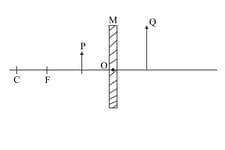Spherical Mirrors
Spherical Mirrors: Overview
This topic covers concepts, such as Spherical Mirror, Pole of a Spherical Mirror, Centre of Curvature of Spherical Mirror, Radius of Curvature of Spherical Mirror, Principal Axis of a Spherical Mirror, Paraxial Ray, Focus of Concave Mirror, Focus of Convex Mirror, Focal Length of a Spherical Mirror, Aperture of a Mirror, Relation between Radius of Curvature and Focal Length of a Spherical Mirror, Derivation of Relation of Focal Length and Radius of Curvature of Spherical Mirrors & Important Rays for the Formation of Images in a Spherical Mirror etc.
Important Questions on Spherical Mirrors
Correct relation between radius of curvature() and Focal length () of a spherical mirror is:
An object is placed at a distance of . From a convex mirror of focal length . The position and nature of the image are :
In the following diagram ‘’ is a mirror and ‘’ is an object and ‘’ is the magnified image of ‘’ formed by the mirror. The mirror ‘’ is a:

A spherical mirror and a thin spherical lens each of focal length are given. The mirror and lens are likely to be:
A concave mirror of focal length 15cm forms an image. The position of the object when the image is virtual and linear magnification is 2 is.
The image formed by a concave mirror is observed to be virtual, erect and larger than the object. Where should be the position of the object?
The ratio of the focal length of spherical mirror to its radius of curvature is
At focus and between and , a concave mirror always forms a
We might have observed that convex mirrors are used in vehicles as rearview mirrors. Convex mirrors are preferred as rearview mirrors because they always produce erect image and has a large field of view compared to plane mirrors. We might have also observed the note written on rearview mirrors saying that objects appearing in the mirror are closer than they appear. Let’s understand how far/close they look in a rearview mirror with this case study.
A car is fitted with a convex mirror as a rearview mirror of radius of curvature . What is the focal length of the mirror?
Assertion(A): The centre of curvature is not a part of the mirror. It lies outside its reflecting surface.
Reason (R): The reflecting surface of a spherical mirror forms a part of a sphere. This sphere has a centre.
The centre of a sphere of which the reflecting surface of a spherical mirror is a part is called
The power of a lens is . What is the focal length of this lens?
